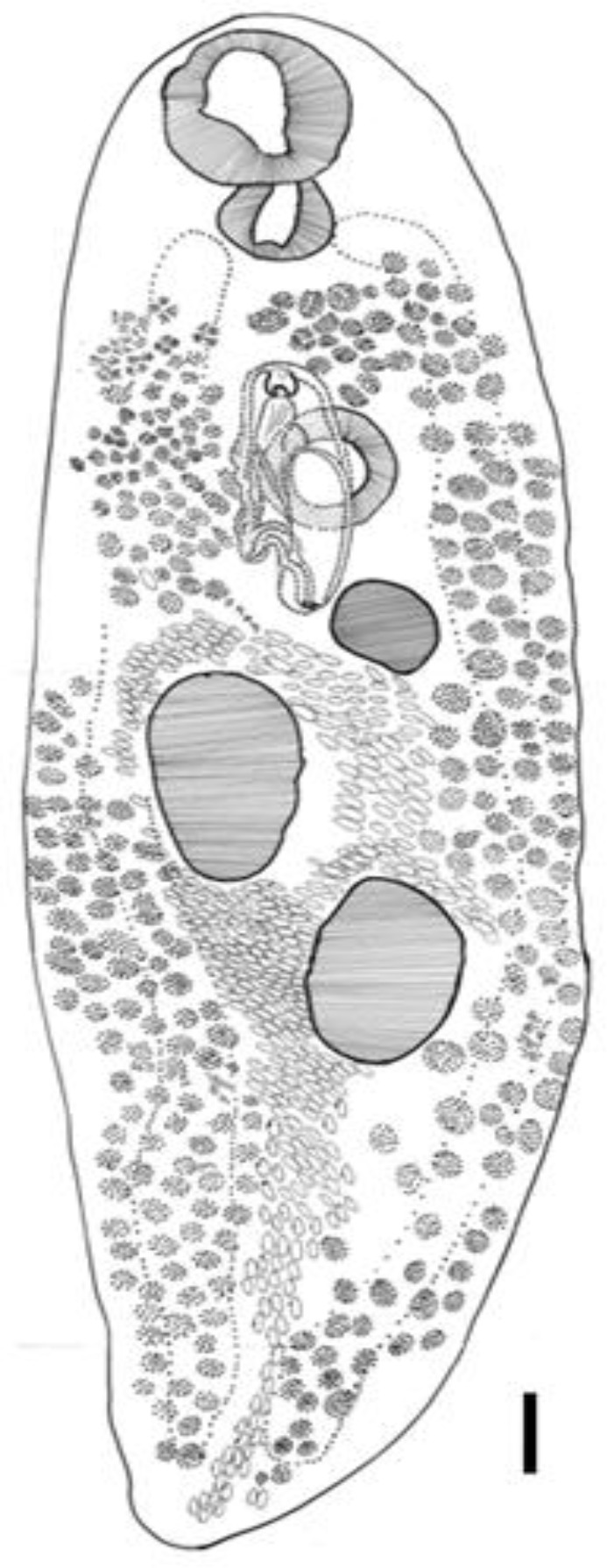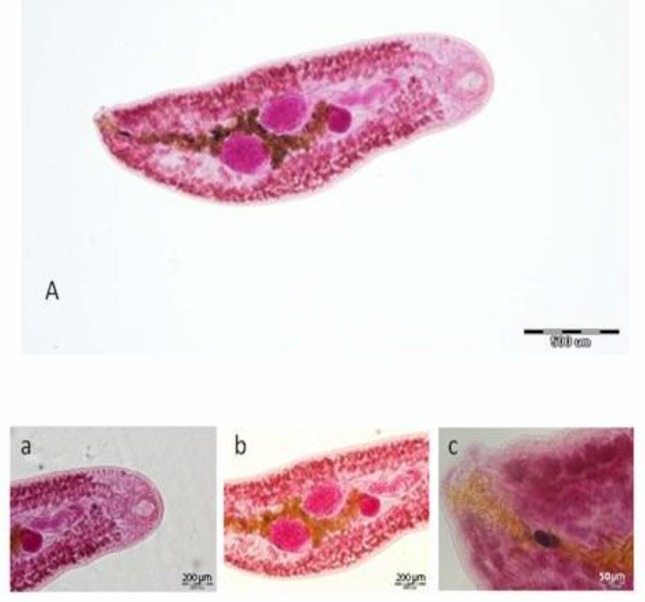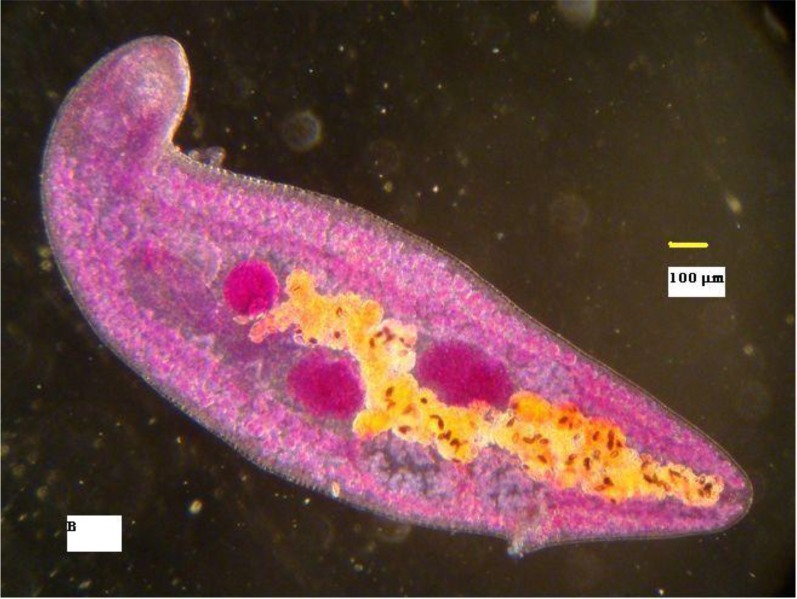Abstract
Rats are capable to harbor various pathogens, among which certain species of zoonotic parasites are included. A long-term detection of parasite fauna of rats has sporadically been carried out in Iran. Abundance of these vertebrate pests is of great importance as regards public health issue. The present paper is focused on a digenean trematode Plagiorchis muris, obtained during a comprehensive study on rats over the decades in the country. Herein we describe this occurrence in a Rattus norvegicus in northern Tehran, with specific note on its morphological description. P. muris can infect human through consumption of infected marine food items, and has never been observed in Iran.
Keywords: Plagiorchis muris, Rattus norvegicus, Trematode, Zoonoses, Iran
Introduction
Various parasitic helminthes among rodents including rats; Rattus rattus and R. norvegicus, have been reported from all over the world (1, 2). Biological behavior of these opportunistic small mammals has facilitated the acquiring and developing of some zoonotic agents as well as specific parasites (2, 3). Merely two exclusive parasites are well known in rats: Trichosomoides crasicuda, commonly named as “Rat bladder worm” and the most prevalent blood protozoa Trypanosoma lewisi. However, many researchers have reported faunistic surveys on rat parasites throughout the world (1, 4, 5) and to some extent in Iran (6, 7) as well. For instance, parasites of rodents such as Plagiorchis muris has been studied in Apodemus silvaticus in Spain (8).
To our knowledge, P. muris has not been recorded in rodents in Iran yet. Several of mammals harbor this intestinal fluke, which feeds freshwater snails such as Lymnaeids as the first intermediate host (9). Bllamya bengalensis, also has recently displayed to be infected with xiphidiocercariae of Plagiorchiidea (10). Mean-while, aquatic insects, insect naiads and fresh water fishes are playing as second intermediate host (11). Furthermore, like other trematodes, P. muris is appearing in a place with multiple environmental and biological factors. Phylogenetic studies indicated that certain species belonging to suborder Plagiorchiata have a paraphyletic nature and parasitize only terrestrial vertebrates (12). Natural human infection however has been reported from Korea, in which, freshwater fishes, snails and insects were claimed as the source of infection among the residents in riversides (9).
The present paper has illustrated the occurrence of P. muris in an urban pest, R. norvegicus which unexpectedly found infected in Tehran, Iran.
Case report
From 2000 to 2010 in a sequential rat controlling program in Iran, random sampling were carried out in the capital Tehran, Ahwaz in the southwest, and Bandar Anzali on the Caspian littoral. Five hundred collected rats were sacrificed individually using diethyl ether anesthesia in the cage or were found dead during the environmental monitoring. Dissection was carefully performed while internal organs were precisely investigated for harboring helminthes. Digestive tract was split lengthwise and gut contents were observed routinely by stereomicroscope. Attained trematodes were prepared to identify morphologically and stained by carmine acid. Complete morphologic and morphometric characters leading to reliable identification were analyzed using a camera lucida. To have a comparative observation, characteristic features of the worm were photographed microscopically and identified taxonomically, based on references (13, 14).The rest of the parasites recovered through these occasions have been exclusive to the rodents and are not regarded in this paper. Out of 500 dissected rats, only one R. norvegicus was seen naturally infected by P. muris with a worm burden of sixty-four. Of those numbers, 19 individuals with appropriate structural condition were selected for measuring and illustrating of morphological characters.
Characters including length 2891 – 1618 (2167) µm, width 831 – 509 (689) µm, distance between the middle points of oral and ventral suckers 765-375 (514) µm, middle of ventral sucker to the posterior end 2151 – 1033 (1473) µm, proximal eggs to the genital pore 41-33.6 × 21.5-15.5(38.4×17.4) µm were carefully measured.
Morphological and morphometrical characters were found compatible with those P. muris that have been already documented in key references (14). The entire body, anterior parts (oral sucker, pharynx and ventral sucker), middle part (ovary, testis and parts of uterus), and posterior end are illustrated below (Fig. 1,a–c, Fig. 2).
Fig. 1.
Plagiorchis muris removed from natural infected R. norvegicus, (A) whole body. (a) Anterior parts: oral sucker, pharynx and ventral sucker, (b) middle part: ovary, testis and parts of uterus, (c) posterior end
Fig. 2.
Whole body stained with Carmine acid, using phase contrast microscopy
The fluke morphology in details illustrating herein has drawn by the use of camera lucida (Fig. 3).
Fig. 3.

Plagiorchis muris in brown rat (Rattus norvegicus) of Tehran, Iran a schematic drawned by Camera Lucida (Scale bar= 100 µm)
Discussion
Comparing with many other prevalent helminthes in rodents, P. muris is not rather common one, which can be browsed throughout the literature (4, 15, 16). P. muris was described for the first time in R. rattus and R. norvegicus in Japan (17). Since then it has been reported from different hosts such as R. rattus, Crocidura sp and Apodemus agrarius in Taiwan, India and Korea respectively (18–20). Parameters measured for these recovered helminthes, were seen similar in size range with those afore-mentioned references.
The rarity of this tiny trematode among considerable number of examined rats, agrees with indication of life cycle complexity that should necessarily employs two biological intermediate hosts in a same foci (21). From public health perspective, P. muris occurrence can be of concern in populations with tendency to seafood and exotic foods, carrying metacercariae as edible items incidentally. Cases that may occur under an unusual condition are exemplary in Japan and Korea (9, 22, 23).
Concerning the human transmission, the expectation seems to be low in Iran due to the cultural behavior, which does not support the means of transmission. Appropriate eco-biological conditions, which had been established for this case in a limited urban place with good level of hygiene in Tehran, attract the researchers to investigate on the life cycle of P. muris in the given area.
The absence of P. muris in the list of the several surveys conducted so far on rat parasitic fauna (6, 7) can be attributed to digenean life cycle complexity. To evaluate the present environmental potentials, which might be led to transmit this zoonotic helminth to humans, a comprehensive field study is needed to be performed in crowded cities of the country.
Acknowledgement
The authors would acknowledge School of Public Health, Tehran University of Medical Sciences and Ahwaz Health Research Station (National Institute of Health Research) for coordinating fieldwork and all support during the survey. The authors declare that there is no conflict of interest.
References
- 1.Sadjjadi SM, Massoud J. Helminth parasites of wild rodents in Khuzestan province, South West of Iran. J Vet Parasitol. 1999;13(1):55–6. [Google Scholar]
- 2.Singla LD, Singla N, Parshad VR, Juyal PD, Sood NK. Rodents as reservoirs of parasites in India. Integr. Zool. 2008;3(1):21–6. doi: 10.1111/j.1749-4877.2008.00071.x. [DOI] [PubMed] [Google Scholar]
- 3.Mohammadzadeh T, Sadjjadi SM, Motazedian MH, Mowlavi GR. Study on the genomic diversity of Hymenolepis nana between rat and mouse isolates by RAPD-PCR. Iran J Vet Res. 2007;8(1):16–9. [Google Scholar]
- 4.Siti Shafiyyah CO, Jamaiah I, Rohela M, Lau YL, Siti Aminah F. Prevalence of intestinal and blood parasites among wild rats in Kuala Lumpur, Malaysia. Trop Biomed. 2012;29(4):544–50. [PubMed] [Google Scholar]
- 5.Tanideh N, Sadjjadi SM, Mohammadzadeh T, Mehrabani D. Helminthic Infections of Laboratory Animals in Animal House of Shiraz University of Medical Sciences and the Potential Risks of Zoonotic Infections for Researchers. Iran RCMJ. 2010;12(2):151–7. [Google Scholar]
- 6.Kia EB, Homayouni MM, Farahnak A, Mohebali M, Shojai S. Study of Endoparasites of Rodents and their Zoonotic Importance In Ahvaz, South West Iran. Iranian J Publ Health. 2001;30(1-2):49–52. [Google Scholar]
- 7.Kia EB, Shahryary-Rad E, Mohebali M, Mahmoudi M, Mobedi I, Zahabiun F, Zarei Z, Miahipoor A, Mowlavi Gh, Akhavan AA, Vatandoost H. Endoparasites of Rodents and Their Zoonotic Importance in Germi, Dashte–Mogan, Ardabil Province, Iran. Iranian J Parasitol. 2010;5(4):15–20. [PMC free article] [PubMed] [Google Scholar]
- 8.Fuentes MV, Sáez S, Trelis M, Galán-Puchades MT, Esteban JG. The helminth community of the wood mouse, Apodemus sylvaticus, in the Sierra Espuna, Murcia, Spain. J Helminthol. 2004;78(3):219–23. doi: 10.1079/joh2003226. [DOI] [PubMed] [Google Scholar]
- 9.Chai JY, Lee SH. Food-borne intestinal trematode infections in the Republic of Korea. Parasitol Int. 2002;51(2):129–54. doi: 10.1016/s1383-5769(02)00008-9. [DOI] [PubMed] [Google Scholar]
- 10.Ghobadi H, Farahnak A. A Faunistic Survey on the Cercariae of Bellamya (Viviparus) bengalensis, Snails and Their Zoonotic Importance. Iranian J Publ Health. 2004;33(2):38–42. [Google Scholar]
- 11.Chai JY, Park JH, Guk SM, Kim JL, Kim HJ, Kim WH, Shin EH, Klein TA, Kim HC, Chong ST, Song JW, Baek LJ. Plagiorchis muris infection in Apodemus agrarius from northern Gyeonggi-do (Province) near the demilitarized zone. Korean J Parasitol. 2007;45(2):153–6. doi: 10.3347/kjp.2007.45.2.153. [DOI] [PMC free article] [PubMed] [Google Scholar]
- 12.Tkach V, Pawlowski J, Mariaux J. Phylogenetic analysis of the suborder Plagiorchiata (Platyhelminthes, Digenea) based on partial lsrDNA sequences. Int J Parasitol. 2000;30(1):83–93. doi: 10.1016/s0020-7519(99)00163-0. [DOI] [PubMed] [Google Scholar]
- 13.Schell SC. How to Know The Trematodes. 1st ed. M.C. Brown: Dubuque Iowa; 1970. [Google Scholar]
- 14.Yamaguti S. New York: Inter Science; 1958. Systema Helminthum Vol. 1. The Digenetic Trematodes of Vertebrates; pp. 244–6. [Google Scholar]
- 15.Seo BS, Rim HJ, Lee CW, Yoon JS. Studies on the helminths of Korea: II. Parasites of the rat, Rattus norvegicus Erxl. in Seoul, with the description of Capillaria hepatica (Bancroft, 1893) Travassos, (1915) Kisaengchunghak Chapchi. 1964;2:55–62. doi: 10.3347/kjp.1964.2.1.55. [DOI] [PubMed] [Google Scholar]
- 16.Stojcevic D, Mihaljevic Z, Marinculic A. Parasitological survey of rats in rural regions of Croatia. Vet Med Czech. 2004;49:70–4. [Google Scholar]
- 17.Tanabe H. Contributions to the knowledge of the developmental cycle of digenetic trematodes. On a new species of trematode Lepoderma muris n.sp. Okayama Igakkai Zasshi. 1922;385:47–57. (in Japanese) [Google Scholar]
- 18.Fischthal JH, Kuntz RE. Some digenetic trematode of mammals from Taiwan. Proc Helminthol Soc Washington. 1975;42:149–57. [Google Scholar]
- 19.Gupta V, Jahan A. On a new trematode, Plagiorchis funambulusi sp.nov. and Plagiorchis muris Tanabe, 1922 Digenea: Plagiorchidae (Luhe, 1901) Ward, 1917 from mammals. Indian J Helminthol. 1978;30(2):143–50. [Google Scholar]
- 20.Seo BS, Rim HJ, Lee CW. Studies on the parasitic helminthes of Korea I. Trematodes of rodents. Korean J Parasitol. 1964;2(1):20–6. doi: 10.3347/kjp.1964.2.1.20. [DOI] [PubMed] [Google Scholar]
- 21.Poulin R, Cribb TH. Trematode life cycles: short is sweet? Trends Parasitol. 2002;18(4):176–83. doi: 10.1016/s1471-4922(02)02262-6. [DOI] [PubMed] [Google Scholar]
- 22.Hong SJ, Woo HC, Chai JY. A human case of Plagiorchis muris (Tanabe, 1922: Digenea) in the Republic of Korea: Freshwater fish as a possible source of infection. J Parasitol. 1996;82(4):647–9. [PubMed] [Google Scholar]
- 23.Asada JI, Otagaki H, Morita M, Takeuchi T, Sakai Y, Kojishi T, Okahashi K. A case report on the human infection with Plagiorchis muris Tanabe, 1922 in Japan. Jpn J Parasitol. 1962;11:512–6. [Google Scholar]




